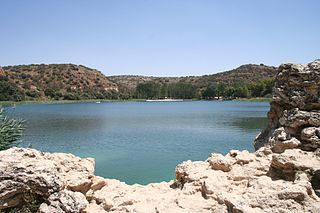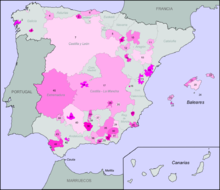
Merlot is a dark blue-colored wine grape variety, that is used as both a blending grape and for varietal wines. The name Merlot is thought to be a diminutive of merle, the French name for the blackbird, probably a reference to the color of the grape. Its softness and "fleshiness", combined with its earlier ripening, makes Merlot a popular grape for blending with the sterner, later-ripening Cabernet Sauvignon, which tends to be higher in tannin.
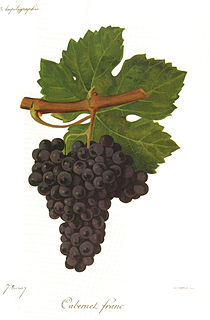
Cabernet Franc is one of the major black grape varieties worldwide. It is principally grown for blending with Cabernet Sauvignon and Merlot in the Bordeaux style, but can also be vinified alone, as in the Loire's Chinon. In addition to being used in blends and produced as a varietal in Canada and the United States, it is sometimes made into ice wine in those regions.

Chilean wine has a long history for a New World wine region, as it was the 16th century when the Spanish conquistadors brought Vitis vinifera vines with them as they colonized the region. In the mid-19th century, French wine varieties such as Cabernet Sauvignon, Merlot, Carmenère and Franc were introduced. In the early 1980s, a renaissance began with the introduction of stainless steel fermentation tanks and the use of oak barrels for aging. Wine exports grew very quickly as quality wine production increased. The number of wineries has grown from 12 in 1995 to over 70 in 2005.
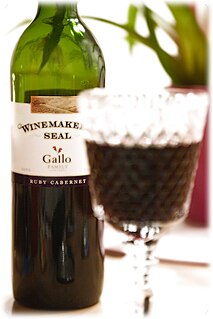
Ruby Cabernet is a red Olmo grape variety that is a cross between Cabernet Sauvignon and Carignan, it can produce wines with good colour and a pleasant cherry flavour, but is mostly blended into bulk wines.

Argentina is the fifth largest producer of wine in the world. Argentine wine, as with some aspects of Argentine cuisine, has its roots in Spain. During the Spanish colonization of the Americas, vine cuttings were brought to Santiago del Estero in 1557, and the cultivation of the grape and wine production stretched first to neighboring regions, and then to other parts of the country.

Washington wine is wine produced from grape varieties grown in the U.S. state of Washington. Washington ranks second in the United States in the production of wine. By 2011, the state had over 43,000 acres (170 km2) of vineyards, a harvest of 142,000 short tons (129,000 t) of grapes, and exports going to over 40 countries around the world from the 850+ wineries located in the state. While there are some viticultural activities in the cooler, wetter western half of the state, the majority (99.9%) of wine grape production takes place in the shrub-steppe eastern half. The rain shadow of the Cascade Range leaves the Columbia River Basin with around 8 inches (200 mm) of annual rain fall, making irrigation and water rights of paramount interest to the Washington wine industry. Viticulture in the state is also influenced by long sunlight hours and consistent temperatures.

Dominio de Valdepusa is a Vino de Pago from Spain. This is the highest category on the quality scale of Spanish wines and means that in addition to having a proven track record of consistent quality, the wines have to be both produced from estate-grown grapes and also have to be processed and aged in a winery (bodega) located on the estate. This Vino de Pago is located in the municipality of Malpica de Tajo, in the province of Toledo and acquired its status in 2003.

Rueda is a Spanish Denominación de Origen (DO) for wines located in the Community of Castile and León. It comprises 72 municipalities, of which 53 are in the province of Valladolid, 17 are in the north of the province of Segovia, and 2 are in the north of the province of Ávila. It is known primarily for its fine white wines based on the verdejo grape.

Utiel Requena is a Spanish Denominación de Origen (DO) for wines located in the province of Valencia. It takes its name from the two neighbouring towns of Utiel and Requena. It is renowned for the predominant use of the Bobal grape variety.

Texas has a long history of wine production. The sunny and dry climate of the major wine making regions in the state have drawn comparison to Portuguese wines. Some of the earliest recorded Texas wines were produced by Spanish missionaries in the 1650s near El Paso. The state is home to over 36 members of the Vitis grape vine family with fifteen being native to the state, more than any other region on earth. As of 2006, the state had over 3,200 acres (1,300 ha) planted with Vitis vinifera. Despite being the largest of conterminous states, this relatively small amount of planted land is dwarfed by the production of even the smallest French AOCs like Sancerre. The Texan wine industry is continuing its steady pace of expansion and has gained a reputation as an established wine growing region in the United States.

Navarra is a Spanish Denominación de Origen (DO) for wines that extends over practically the entire southern half of the autonomous community of Navarre. The vineyards are on the lower slopes of the Pyrenees as they descend towards the basin of the river Ebro.

Marselan is a red French wine grape variety that is a cross between Cabernet Sauvignon and Grenache. It was first bred in 1961 by Paul Truel near the French town of Marseillan. The vine is grown mostly in the Languedoc wine region with some plantings in the Northern Coast of California. It has also become very popular in China. The grape usually produces a medium body red wine.

Catalan wines are those that are produced in the wine region of Catalonia. Occasionally, the appellation is applied to some French wine made in the Catalan region of Roussillon because of the transfer of French territories that currently are part of Spain. The city of Barcelona is the capital of Catalonia and despite not being in a wine region it is the focal point of the Catalan wine industry: a primary consumer market, its port provides export functions and a source of financial resources and investment.

Founded in 1870 by Jaime Torres, Bodegas Torres is a historical wine growing company located in Pacs, some 4 km from Vilafranca del Penedès, where the company has its head office. Torres is the family winery with the most extensive vineyards in the Denomination of Origin (DO) of Penedès and the largest winery in Spain.

Mexican wine and wine making began with the arrival of the Spanish in the 16th century, when they brought vines from Europe to modern day Mexico, the oldest wine-growing region in the Americas. Although there were indigenous grapes before the Spanish conquest, the Spaniards found that Spanish grapevines also did very well in the colony of New Spain (Mexico) and by the 17th century wine exports from Spain to the New World fell. In 1699, Charles II of Spain prohibited wine making in Mexico, with the exception of wine for Church purposes. From then until Mexico’s Independence, wine was produced in Mexico only on a small scale. After Independence, wine making for personal purposes was no longer prohibited and production rose, especially in the late 19th and early 20th centuries. Many other European immigrant groups helped with the comeback of wine in Mexico. However, the Mexican Revolution set back wine production, especially in the north of the country. Wine production in Mexico has been rising in both quantity and quality since the 1980s, although competition from foreign wines and 40% tax on the product makes competing difficult within Mexico. Mexico is not traditionally a wine-drinking country, but rather prefers beer, tequila and mezcal. Interest in Mexican wine, especially in the major cities and tourists areas, has grown along with Mexican wines’ reputation throughout the world. Many Mexican companies have received numerous awards. Various wine producers from Mexico have won international awards for their products.
Finca Élez is a Vino de Pago from Spain. This is the highest category on the quality scale of Spanish wines and means that in addition to having a proven track record of consistent quality, the wines have to be both produced from estate-grown grapes and also have to be processed and aged in a winery (bodega) located on the estate. This Vino de Pago is located in the municipality of El Bonillo, in the province of Albacete and acquired its status in 2002.
Dehesa del Carrizal is a Vino de Pago from Spain. This is the highest category on the quality scale of Spanish wines and means that in addition to having a proven track record of consistent quality, the wines have to be both produced from estate-grown grapes and also have to be processed and aged in a winery (bodega) located on the estate.

British Columbia wine is Canadian wine produced in the province of British Columbia. Wines made from 100 percent British Columbia grapes can qualify for classification under one of British Columbia's two classification systems, depending on the variety, the wine-making techniques employed, and various other restrictions.
Campo de la Guardia is a Vino de Pago from Spain. This is the highest category on the quality scale of Spanish wines and means that in addition to having a proven track record of consistent quality, the wines have to be both produced from estate-grown grapes and also have to be processed and aged in a winery (bodega) located on the estate.
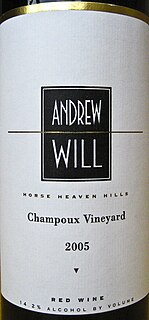
Champoux Vineyard is a grape growing estate located in the Horse Heaven Hills AVA of Washington State. Grapes grown in the vineyard have been used to produce some of the most critically acclaimed Washington wines with the name Champoux regularly being featured on vineyard designated wines. Paul Gregutt, wine writer for the Seattle Times and Wine Enthusiast, list Champoux as one the "top ten" vineyards in the entire state. Cabernet Sauvignon grapes from Champoux vineyards were featured in the consecutive 100 point Robert Parker rated wines from Quilceda Creek Vintners for the 2002 and 2003 vintages.


